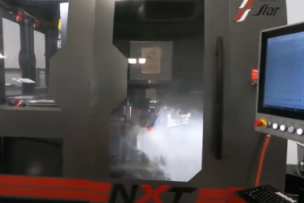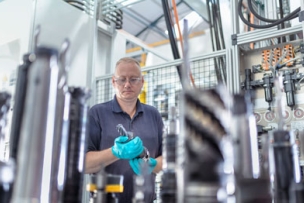Joe Gibbs Racing: The Championship Team You Don’t See on the Track
What does it take to build a Cup Series champion? It takes a whole lot of custom manufacturing and machining experience—and teamwork behind the scenes.
In a 400,000-square-foot facility in Huntersville, North Carolina, a leading racing organization’s manufacturing team is in a constant race against time to help keep the organization’s drivers near the front of the pack in the NASCAR standings.
The team works for Joe Gibbs Racing (JGR), a stock car, truck and motorcycle racing outfit owned and operated by legendary Washington Redskins coach Joe Gibbs and his sons, J. D. and Coy Gibbs. JGR has 600 employees, the majority of which are divided into two divisions, competition and manufacturing. The competition division includes JGR’s four Nascar Cup teams, three Xfinity teams, one Arca team, four Supercross/Motocross teams and an engine development department, as well as personnel that set up vehicles for the track they’ll be racing on during the coming weekend. This division is also responsible for transporting vehicles and staff to and from their racing destinations using tractor-trailers and JGR’s three planes.
But the competition division doesn’t get the vehicles until the manufacturing division is finished with them. The manufacturing team includes roughly 70 engineers and 24 CNC machinists supported by four CNC programmers, as well as dozens of fabricators and mechanics. The manufacturing team is constantly busy building new vehicles (the life of a typical JGR race car is only about three or four races) and improving existing ones.
Custom In-House Racing Vehicle Manufacturing
JGR manufactures about 90 percent of the parts and pieces that go into its vehicles, explains Mark Bringle, the company’s technical sponsorship and marketing director. There are several reasons for the heavy reliance on in-house manufacturing.
For one, JGR has won four Cup Series championships since 2000, and doesn’t want its technical ingenuity and engineering expertise to leave the building.
“When we find something that gives us a competitive edge, we don’t want it sitting with an outside company with a three-week delivery time,” Bringle says. “For a quick turnaround, it’s a lot easier to go down to our shop than it is to deal with an outside vendor.”
Since part failures can result in driver injuries or worse, JGR is also confident that its own operation can produce the best part quality. To help ensure this, the company created a state-of-the-art metrology lab that checks critical part characteristics such as accuracy, form and surface finish. JGR also employs a fault engineer who evaluates the metals used in the manufacturing team’s CNC processes and makes suggestions about materials. The fault engineer also checks components purchased from outside vendors.
In JGR’s fab room, about 75 people are involved in the process of building a race car. They start by constructing the chassis, which takes about a week. The chassis then goes to NASCAR’s certification facility for measurement. When JGR gets it back, fabricators hang the body panels on the car, which takes another week. Then about 40 mechanics go to work, installing the engine and other components. Finished cars are normally ready for the competition division three weeks from the start of the building process.
Dedicated Metalworking Operation
Metal components for JGR vehicles are virtually certain to pass through the company’s metalworking operation. “I would be shocked if you could find a part on a car that we haven’t modified or manufactured from scratch,” says senior engineer Dan Olson. In addition, Olson says, JGR makes all the supporting tooling and fixturing needed for body hanging and chassis fabrication.
JGR has 34 CNC machines operating two shifts a day. The equipment includes 20 mills, seven lathes, four electrical discharge machines (EDM), a laser cutter, a water-jet cutter and a 3-axis router. The primary metals machined are steel, aluminum and titanium.
“We don’t do big production runs, and we don’t have any machines dedicated to one item,” Olson notes. “Every day a machine will make small batches of two or three different parts.”
Components for chassis fabrication are mainly tubing and metal sheets that are cut, bent and welded in place. Sheet metal is also used for body panels. According to Olson, many of the panels used are stamped at an outside factory and then modified by JGR to get the proper fit and/or aerodynamic characteristics.
Panels are attached to the race cars with stobs, short steel tubes that are welded to the panels and chassis. This procedure is different from the seam welding process used to attach the body panels of typical production vehicles. The use of stobs allows JGR’s manufacturing team to change panel shape, location and orientation more quickly and easily than would be possible with ordinary car panels, Olson explains.
“We only see what’s going on in our facility, but the MSC rep is out in the field in a lot of shops. He sees all different applications and situations where products are used, so he can make recommendations about what products we need.”
Another Key, Behind-the-Scenes Success
For many years, Olson and the rest of JGR’s manufacturing team have benefited from their relationship with MSC Industrial Supply Co., which supplies JGR with hundreds of manufacturing and MRO products from leading suppliers. As much as 40 percent of the products used by the manufacturing division comes from MSC, according to Dan Schnars, a JGR manufacturing engineer. Other key products acquired from MSC include manual mills, fasteners and abrasives, as well as safety equipment such as glasses, earplugs and gloves.
When replenishing its product inventory, JGR takes advantage of MSC’s time- and money-saving ControlPoint Customer Managed Inventory Management vending tool. Users simply scan the bar code of the product they want to order, connect the scanner to a PC and automatically insert the product in a shopping cart on mscdirect.com to complete the ordering process.
Using the ControlPoint inventory-management system, “we are able to better track tooling usage and have greatly reduced excess inventory on the shop floor, which has resulted in a product spend reduction of over 25 percent overall in our shop,” reports JGR owner Joe Gibbs.
Once products are ordered, fast delivery is crucial to JGR, which must meet a demanding weekly racing schedule. “If we break something, we’re going to be redesigning and manufacturing it within hours of when it broke,” Schnars notes. “In order to live in that environment, we can’t wait for something to come in three or four days later because we wouldn’t be able to get parts on race cars for the next week. We need suppliers like MSC that can get stuff here overnight.”
MSC’s speedy delivery also allows designers like Olson to get through design and prototyping cycles more rapidly. “With next-day delivery, we always have the resources we need,” he says.
Besides fast delivery, JGR relies on technical support provided by MSC. “We only see what’s going on in our facility,” says Schnars. “But the MSC rep is out in the field in a lot of shops. He sees all different applications and situations where products are used, so he can make recommendations about what products we need.”
In some cases, the issue is how to machine a particularly challenging material. “If we have a problem cutting a certain exotic metal, we will call MSC and their metalworking specialists will give us support,” says Bringle, adding that “it’s nice to have that knowledge come along with their products.”
Now that you have the inside scoop on Joe Gibbs Racing, tell us about your shop: How many CNCs are you running? Do you use in-house metrology? Swap shop stories here.




Talk to Us!
Hi my name is Dean Compton I have a Toyota Camry race car. I was told it was Denny Hamlin's # 11 fed ex car it appears to be mile and a half car I'm going from the steering box that is in the car. I was told it was wrecked at Atlanta motor speedway and then rear clipped. I also work at Ryerson metals in Georgia and am a mechanic on our Tube lasers among other machines. I would like to know if there is any way I could buy some used parts to complete my dream car after looking and working on the car I understand that a lot of the parts were custom built by JGR which makes them hard to locate. Any help to complete my dream car would be greatly appreciated. Thanks
218Hi Dean, thanks for visiting and for your interest. You can try to post in our forums to connect with other folks who may have used parts for sale.
https://www.mscdirect.com/betterMRO/forum
198Leave a reply
Your email address will not be published. Required fields are marked *